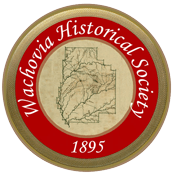The Archie K. Davis Award, named for the late banker, businessman and scholar, is awarded by the Wachovia Historical Society to honor an individual who has made significant contributions to regional and cultural history.
The first Davis Award was presented to Mrs. Louise Kapp. Other past recipients have included the late Chester S. Davis, the late James A. Gray, the late Frank Horton, Dr. C. Daniel Crews, and Flora Ann Bynum.
Tonight we are privileged to present the seventh Archie K. Davis award. And for this award, we are departing from our night’s emphasis on things female and celebrating a Moravian male’s accomplishments.
This year’s award recognizes a man whose style of leadership speaks quietly but well of his Moravian ancestry—an abiding faith, a love of family, a keen interest in preserving history, and continuing service to his community.
Perhaps some of his skills in managing and operating textile businesses and commercial real estate, as well as a non-profit historic restoration, can be traced to his ancestor Jacob Loesch (Lash), a minister called as the vorsteher, or business manager, for the first 12 men who settled in Wachovia in 1753. Of course, earning his MBA from Harvard might have prepared Robert Arthur Spaugh to work in those areas as well.
In mentioning Arthur’s forebears, I should also mention his father, Rufus Arthur Spaugh, who was instrumental in beginning the restoration of Salem and who helped organize Old Salem Inc. Arthur’s family today includes his wife, Mary Jo, retired elementary school teacher, son Rob, an attorney, daughter Merrily, a paralegal, and three grandchildren.
A native son of Winston-Salem, Arthur grew up in Home Moravian Church, and is still an active servant leader in that congregation as well as in the Southern Province. He graduated from Reynolds High School and later from the University of North Carolina at Chapel Hill.
In 1973 when Arthur became president of Old Salem Inc., the non-profit group was just 23 years old. For the next 13 years, the appropriate and accurate restoration, preservation, and interpretation of the historic town of Salem would be Arthur’s consuming goal. Although much had been accomplished, much remained to be done.
With his usual quiet determination to get things done, and get them done properly, Arthur led Old Salem in an intensive effort which saw 15 historic buildings restored, including the complete restoration of the Vierling House at the top of Church Street, originally built for Dr. Benjamin Vierling in 1802, for use as a house museum, and the reconstruction of the Single Brothers Workshop, for use as an education center. As Arthur notes, with the support of a strong staff and backed by a willing community, along with the restoration of the 15 buildings, Old Salem launched a horticulture and landscape restoration program, opened a museum store in the 1775 Community building, removed 24 non-conforming properties and transferred 64 properties, including the properties now restored along Factory Row or Trade Street during this period. You can tell this man is not afraid of hard work!
And, even though he stayed busy at Old Salem, he still found time to participate in activities with the Boy Scouts of America, an interest he has maintained over the last 55 years, serving currently on the executive board of the Old Hickory Council. The YMCA and the Rotary Club of Winston-Salem elected him president, and Arthur has served on other community boards too numerous to list.
During Arthur’s several years of service to the Wachovia Historical Society, he worked diligently and with untiring perseverance on a long-standing mission of the Society —to convert the Adam Spach rock house property into a public space. And after 70 some years of trying on the Society’s part, Arthur almost pulled it off! Plans were drawn for a beautiful public park that would have allowed visitors to see and enjoy the remains of the Spach farm, built just south of the original Wachovia Tract in the mid-1700s, near the current Friedberg Moravian Church. Arthur made numerous trips to Davidson County and to Raleigh to seek permissions, funds, grants and agreements, and it looked like it would all work out. But, due to circumstances beyond his control, it was not to be—at this time. The Society continues to work on this project, but we will always be indebted to Arthur for the many, many hours he devoted to this cause and the fine work he did on behalf of the Society on the Spach rock house property.
Now, looking back again to Arthur’s role with Salem…Those who are fortunate to live in or visit Old Salem today sense the solidity and tranquility of this place—and yet there is also a liveliness about it—people live and work there, sleep there, teach and learn and pray there, sing and make music together there—in other words, the spirit of those early Moravians who founded Salem presents itself still, in all these wonderful ways, along the shaded streets and in the gardens, in the restored and reconstructed houses and public buildings. And this continuation of spirit, this presence of its founders, did not just happen. It took years of careful planning and hard work—and above all a desire to see that history was correctly interpreted to all those who came to see what Salem and the Moravians were all about. And Arthur—a quiet leader with dedicated determination and the spirit of his Moravian ancestors–played a major role in bringing that about.
Tonight we salute Robert Arthur Spaugh for the part he has played in tending to the care and well-being of Salem’s legacy—and for his generous contributions in so many ways to preserving, celebrating and passing on the spirit of Salem, Wachovia, and the North Carolina Moravians, past and present.




